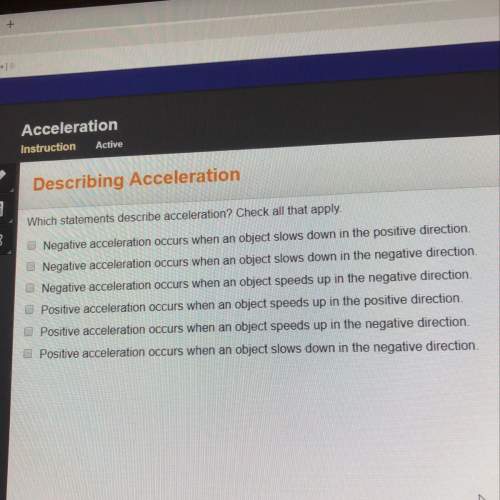
A beam of light passes through the air (n = 1.00) and enters a diamond (n - 2.42) at an angle of incidence of 40 degrees . Use Snell's Law to find the angle of refraction in the diamondIf the diamond is placed in a tank of water (n - 1.33) and the beam of light enters the diamond at the same angle of incidence, what would be the new angle of refraction Show all work

Answers: 1


Another question on Physics

Physics, 21.06.2019 23:00
Follow these directions and answer the questions. 1. set up the ripple tank as in previous investigations. 2. bend the rubber tube to form a "concave mirror" and place in the ripple tank. the water level must be below the top of the hose. 3. generate a few straight pulses with the dowel and observe the reflected waves. do the waves focus (come together) upon reflection? can you locate the place where the waves meet? 4. touch the water surface where the waves converged. what happens to the reflected wave? 5. move your finger twice that distance from the hose (2f = c of c, center of the curvature) and touch the water again. does the image (the reflected wave) appear in the same location (c of c)? you may have to experiment before you find the exact location. sometimes it is hard to visualize with the ripple tank because the waves move so quickly. likewise, it is impossible to "see" light waves because they have such small wavelengths and move at the speed of light. however, both are examples of transverse waves and behave in the same way when a parallel wave fronts hit a curved surface.
Answers: 1

Physics, 22.06.2019 03:30
The solar panels used by mark function because of the photoelectric effect. light shines on the cells causing electrons to be ejected from the metal, which produces an electric current. at night on mars, no light will fall on the solar cells and no electric current will be generated. according to your notes, what type of light is typically needed to cause the photoelectric effect? a)visible b)ultraviolet c)infrared
Answers: 1

Physics, 22.06.2019 05:00
In a stagnant pool of water, a crayfish may spend much of its time lying with one side of its carapace near the surface of the water. in this position, it will move the walking legs on that side in a rhythmic back-and-forth motion. explain the likely function of this behavior.
Answers: 1

Physics, 22.06.2019 10:00
The rocket is fired vertically and tracked by the radar station shown. when θ reaches 66°, other corresponding measurements give the values r = 32700 ft, r¨ = 85 ft/sec2, and θ˙ = 0.019 rad/sec. calculate the magnitudes of the velocity and acceleration of the rocket at this position.
Answers: 3
You know the right answer?
A beam of light passes through the air (n = 1.00) and enters a diamond (n - 2.42) at an angle of inc...
Questions



Biology, 19.12.2019 23:31









Computers and Technology, 19.12.2019 23:31



Physics, 19.12.2019 23:31




Physics, 19.12.2019 23:31




